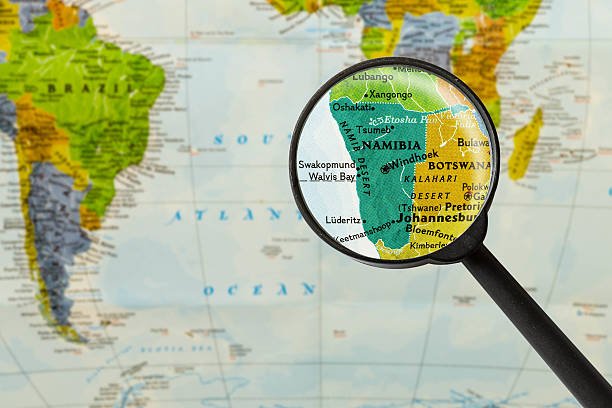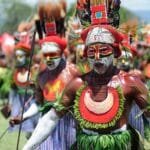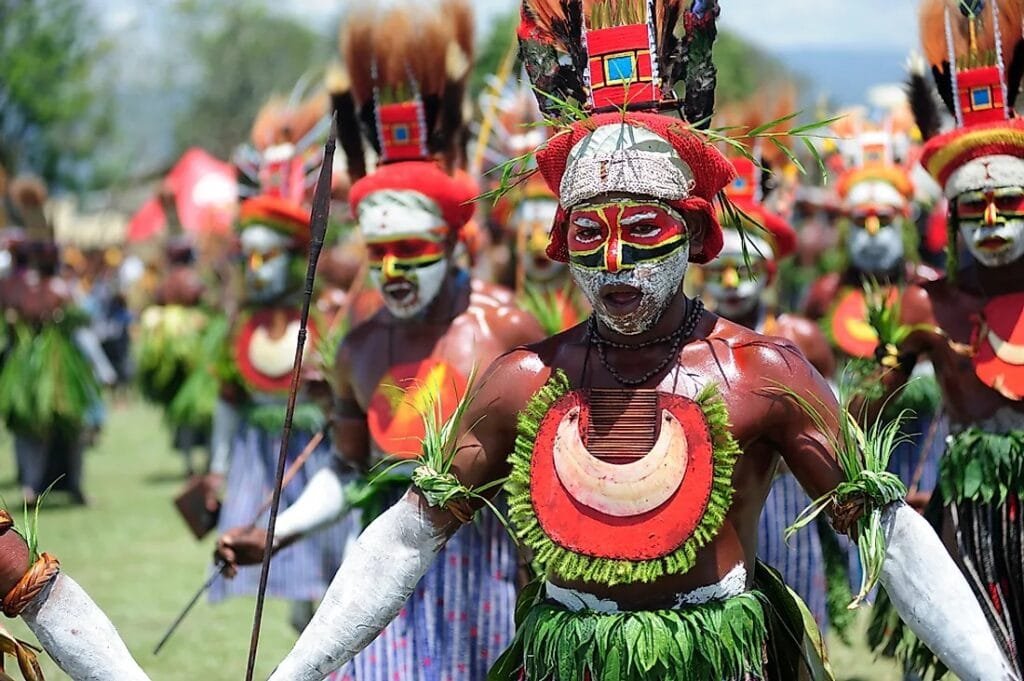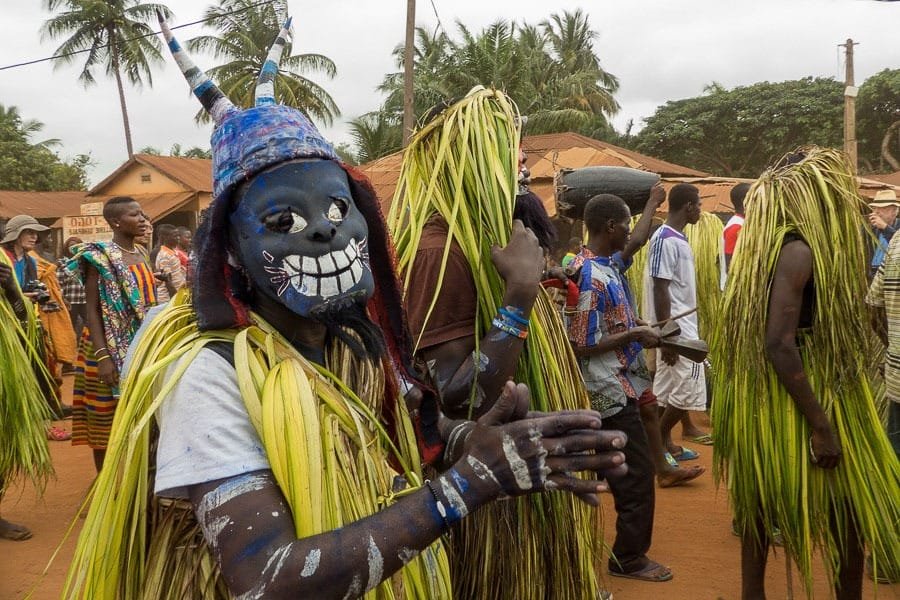Namibia, officially the Republic of Namibia, is a country on the west coast of Southern Africa. Its borders include the Atlantic Ocean to the west, Angola and Zambia to the north, Botswana to the east and South Africa to the south.
Namibia’s capital and largest city is Windhoek. English is the national language.
The name of the country is derived from the Namib desert, the oldest desert in the world. The word Namib itself is of Khoi origin and means “vast place.” The name was chosen by Mburumba Kerina, who originally proposed “Republic of Namib.”
Before Namibia became independent in 1990, its territory was known first as German South-West Africa (Deutsch-Südwestafrika), and then as South West Africa, reflecting its colonial occupation by Germans and South Africans, respectively.
With a population of 3.1 million people, Namibia is one of the most sparsely populated countries in the world. It has the second-lowest population density of any sovereign country, after Mongolia, as well as having the lowest population density of any sovereign country with a coastline.
With more than 80 percent of its adult population literate, Namibia has one of the highest rates of literacy in sub-Saharan Africa.
The Christian community makes up 80%–90% of the population of Namibia, with at least 75% being Protestant, of which at least 50% are Lutheran. Lutherans are the largest religious group, a legacy of the German and Finnish missionary work during the country’s colonial times. 10%–20% of the population hold indigenous beliefs. Islam in Namibia is subscribed to by about 9,000 people, many of them Nama.
The majority of Namibians can speak and understand English and Afrikaans. Ovambo languages are spoken by more than 80 percent of the population, followed by Nama-Damara with about 6 percent.
At 825,615 km2 (318,772 sq mi), Namibia is the world’s thirty-fourth largest country. It lies mostly between latitudes 17° and 29°S (a small area is north of 17°), and longitudes 11° and 26°E.
Namibia is the driest country in sub-Saharan Africa. Being situated between the Namib and the Kalahari deserts, Namibia has the least rainfall of any country in sub-Saharan Africa.

The Namibian landscape consists generally of five geographical areas, each with characteristic abiotic conditions and vegetation, with some variation within and overlap between them: the Central Plateau, the Namib, the Great Escarpment, the Bushveld, and the Kalahari Desert.
The Central Plateau runs from north to south, bordered by the Skeleton Coast to the northwest, the Namib Desert and its coastal plains to the southwest, the Orange River to the south, and the Kalahari Desert to the east. The Central Plateau is home to the highest point in Namibia at Königstein elevation 2,606 metres (8,550 ft).
The Namib is a broad expanse of hyper-arid gravel plains and dunes that stretches along Namibia’s entire coastline. It varies between 100 and 200 kilometres (60 and 120 mi) in width. Areas within the Namib include the Skeleton Coast and the Kaokoveld in the north and the extensive Namib Sand Sea along the central coast.
The Great Escarpment swiftly rises to over 2,000 metres (7,000 ft). Average temperatures and temperature ranges increase further inland from the cold Atlantic waters, while the lingering coastal fogs slowly diminish. Although the area is rocky with poorly developed soils, it is significantly more productive than the Namib Desert. As summer winds are forced over the Escarpment, moisture is extracted as precipitation.
The Bushveld is found in north-eastern Namibia along the Angolan border and in the Caprivi Strip. The area receives a significantly greater amount of precipitation than the rest of the country, averaging around 400 mm (16 in) per year. The area is generally flat and the soils sandy, limiting their ability to retain water and support agriculture.
The Kalahari Desert, an arid region that extends into South Africa and Botswana, is one of Namibia’s well-known geographical features. The Kalahari, while popularly known as a desert, has a variety of localised environments, including some verdant and technically non-desert areas. The Succulent Karoo is home to over 5,000 species of plants, nearly half of them endemic; approximately 10 percent of the world’s succulents are found in the Karoo. The reason behind this high productivity and endemism may be the relatively stable nature of precipitation.
Namibia’s Coastal Desert is one of the oldest deserts in the world. Its sand dunes, created by the strong onshore winds, are the highest in the world. Because of the location of the shoreline, at the point where the Atlantic’s cold water reaches Africa’s hot climate, often extremely dense fog forms along the coast. Near the coast there are areas where the dune-hummocks are vegetated. Namibia has rich coastal and marine resources that remain largely unexplored. The Caprivi Strip extends east from the northeastern corner of the country.
Namibia was inhabited since prehistoric times by the Khoi, San, Damara and Nama people. Around the 14th century, immigrating Bantu peoples arrived as part of the Bantu expansion. From 1600 the Ovambo formed kingdoms, such as Ondonga and Oukwanyama.
In 1884, the German Empire established rule over most of the territory, forming a colony known as German South West Africa. Between 1904 and 1908, German troops waged a punitive campaign against the Herero and Nama which escalated into the first genocide of the 20th century. German rule ended during the First World War with a 1915 defeat by South African forces.
In 2021, German and Namibian diplomats created a “reconciliation agreement” acknowledging atrocities from the German colonial period. In 1920, after the end of the war, the League of Nations mandated administration of the colony to South Africa. From 1948, with the National Party elected to power, this included South Africa applying apartheid to what was then known as South West Africa.
In the later 20th century, uprisings and demands for political representation resulted in the United Nations assuming direct responsibility over the territory in 1966, but South Africa maintained de facto rule until 1973. That year the UN recognized the South West Africa People’s Organisation (SWAPO) as the official representative of the Namibian people.
Namibia gained independence from South Africa on 21 March 1990, following the South African Border War. However, Walvis Bay and the Penguin Islands remained under South African control until 1994.
Namibia is a member state of the United Nations, the Southern African Development Community, the African Union and the Commonwealth of Nations.
GOVERNANCE
Namibia is a unitary democratic republic. The President of Namibia is elected to a five-year term and is both the head of state and the head of government. All members of the government are individually and collectively responsible to the legislature.
The country’s constitution, which took effect at independence in 1990 and has since been amended, is highly rights-conscious and aimed at achieving a durable separation of powers.
While the constitution envisaged a multi-party system for Namibia’s government, the South West Africa People’s Organization (SWAPO) party has been dominant since independence in 1990.
Executive branch
Executive power is vested in the President, who serves as head of state and government and is directly elected to a five-year term. The Vice President is appointed by the President, and the cabinet consists of the Prime Minister and other ministers who are also appointed by the President.
Netumbo Nandi-Ndaitwah is currently the President. She is first woman to serve as President of Namibia. Lucia Witbooi is the Vice President and Elijah Ngurare serves as Prime Minister.
Legislative branch
Namibia has a bicameral Parliament with the National Assembly as lower house, and the National Council as the upper house. The National Assembly, is constituted to initiate and pass legislation. It consists of 96 members who are directly elected to five-year terms under universal adult suffrage and up to 8 members who are appointed by the president and do not have voting rights.
The upper house, the National Council, serves in an advisory capacity on legislative matters and comprises three representatives from each of Namibia’s 14 administrative regions. National Council members are elected by Regional Councils and serve six-year terms.
Saara Kuugongelwa-Amadhila, who had previously served as Prime Minister, is now Speaker of the National Assembly; the first woman to hold that post.
Judicial branch
The judicial system comprises the Supreme Court, the High Court, and lower courts. The Supreme Court is the highest court of law in the country. The courts operate completely independent of the executive and legislative branches of the government with their primary goal to uphold the law of Namibia. The judiciary is responsible for the interpretation of laws as well as decisions pertaining to the behavior of the state and government officials.
Administrative divisions
Namibia is divided into 14 regions which are subdivided into 121 constituencies. The administrative division of Namibia is tabled by Delimitation Commissions and accepted or declined by the National Assembly. The most urbanised and economically active regions are the Khomas and Erongo regions, with Khomas home to the capital, Windhoek, and Erongo home to Walvis Bay and Swakopmund.
ECONOMY
Agriculture, tourism and the mining industry – including mining for gem diamonds, uranium, gold, silver and base metals – form the basis of its economy, while the manufacturing sector is comparatively small.
Namibia’s economy is tied closely to South Africa’s due to their shared history. In Q3 2023, the largest economic sectors were mining (18.0% of GDP), public administration (12.9%), manufacturing (10.1%), and education (9.2%).
Namibia’s economy is heavily dependent on the earnings generated from primary commodity exports in a few vital sectors, including minerals, especially diamonds, livestock, and fish. Furthermore, the Namibian economy remains integrated with the economy of South Africa.

Despite significant GDP growth since its independence, poverty and inequality remain significant in the country. 40.9% of the population is affected by multidimensional poverty, and more than 400,000 people continue to live in informal housing. Income disparity in the country is one of the world’s highest with a Gini coefficient of 59.1 in 2015.
Although per capita GDP is five times the per capita GDP of Africa’s poorest countries, the majority of Namibia’s people live in rural areas and have a subsistence way of life. Namibia has one of the highest rates of income inequality in the world, due in part to the fact that there is an urban economy and a more rural cashless economy. The inequality figures take into account people who do not actually rely on the formal economy for their survival.
47% of imports originate predominantly from South Africa as a result of long-standing business links, proximity, and, until 1992, Namibia’s membership in the Southern African Customs Union. Major imports include food, consumer goods, fuel, and capital goods.
Namibia’s exports constitute up to 90 percent of the goods produced. Diamonds; uranium oxide; meats, furs, and other animal products; base metals; fish; and gold are shipped to South Africa, other neighboring countries, and Western Europe.
AGRICULTURE
About half of the population depends on agriculture (largely subsistence agriculture) for its livelihood, but Namibia still imports some of its food. Although arable land accounts for less than 1% of Namibia, (about 0.97%), nearly half of the population is employed in agriculture. Agriculture is increasingly under pressure, due to factors such as frequent and prolonged droughts as well as woody plant encroachment. Commercial fishing and fish processing is the fastest-growing sector of the Namibian economy in terms of employment, export earnings, and contribution to GDP.
INDUSTRY
In 2023, industry contributed approximately 30.02 percent of the country’s GDP
Manufacturing
Manufacturing produces about 5 percent of the GDP. It is dominated by meat and fish processing, brewing, and light engineering work (especially metal fabrication). Strategic growth areas include light engineering, building materials, and salt- and natural-gas-based chemical processing, plus import substitution and consumer goods. Namibian manufacturing is inhibited by a small domestic market, dependence on imported goods, limited supply of local capital, widely dispersed population, small skilled labour force and high relative wage rates, and subsidised competition from South Africa. Namibia also boasts world-class civil aviation facilities and an extensive, well-maintained land transportation network.
Extractives
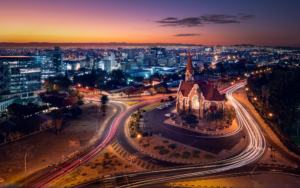
Providing 25% of Namibia’s revenue, mining is the single most important contributor to the economy. Namibia is the fourth largest exporter of non-fuel minerals in Africa. There have been significant investment in uranium mining and Namibia hoped to become the largest exporter of uranium by 2015. However, as of 2019 Namibia continued to produce 750 tons of uranium annually making it a smaller than average exporter in the competitive world market. Rich alluvial diamond deposits make Namibia a primary source for gem-quality diamonds. While Namibia is known predominantly for its gem diamond and uranium deposits, a number of other minerals are extracted industrially such as lead, tungsten, gold, tin, fluorspar, manganese, marble, copper and zinc. Also, there are offshore gas deposits in the Atlantic Ocean that are planned to be extracted in the future. Estimates updated in 2022 suggest that two exploration wells in the offshore Orange Basin could hold 2 and 3 billion barrels of oil, respectively.
Electricity is generated mainly by thermal and hydroelectric power plants. Non-conventional methods of electricity generation also play some role.
Construction
Despite the remote nature of much of the country, Namibia has seaports, airports, highways, well-maintained roads, infrastructure and railways (narrow-gauge). It is an important regional transportation hub for its seaports and trade with landlocked neighboring countries. The Central Plateau already serves as a transportation corridor from the more densely populated north to South Africa, the source of four-fifths of Namibia’s imports. The trans-African automobile route – the Tripoli-Cape Town Highway and the Trans-Kalahari Corridor pass through Namibia.
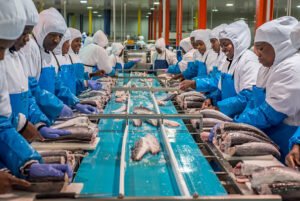
SERVICES
Namibia continues to have a strong services sector mainly underpinned by strong hospitality, wholesale and retail as well as the transport sector industries. Meanwhile, according to the 2018 Labour force survey, employment in the services sector rose by 22.6 percent from 299,963 people in 2012 to 367,791 people in 2018.
In 2023, the services sector contributed about 53.4 percent of the GDP.
Services employ 62 per cent of people in the labour force. In services, the most important sub-sectors are public administration, financial services, retail and wholesale trade, tourism, transport and communication. Tourism is the main driver of this sector, contributing 10 per cent directly to the GDP.
Banking
Namibia has a highly developed banking and financial services sector with modern infrastructures, such as online banking and cellphone banking. The Bank of Namibia (BoN) is the central bank of Namibia responsible for performing all other functions ordinarily performed by a central bank.
The banking sector in Namibia comprises nine authorized banking institutions, which are categorized as seven commercial banking institutions, namely; Bank Windhoek Limited, First National Bank Namibia Limited, Standard Bank Namibia Limited, Nedbank Namibia Limited, Bank BIC Namibia Limited, Letshego Bank Namibia Limited and Banco Atlántico (branch of a foreign banking institution)
The Bank of Namibia launched an independent currency, the Namibian dollar, to replace the South African rand in the mid-1990s.
Tourism
Tourism is a major contributor (14.5%) to Namibia’s GDP, creating tens of thousands of jobs (18.2% of all employment) directly or indirectly and servicing over a million tourists per year. The country is a prime destination in Africa and is known for ecotourism, which features Namibia’s extensive wildlife. Namibia has various species of wildlife including the wild dog, dik dik and critically endangered black rhino. There are 200 terrestrial mammal species, 645 bird species and 115 fish species.
Namibia has established several parks and reserves to celebrate and protect its rich plant and animal life. These include Etosha National Park, Skeleton Coast Park, Namib-Naukluft Park, and Sperrgebiet National Park. |Ai-|Ais and Fish River Canyon Park, along Namibia’s southern border, merged with South Africa’s Richtersveld National Park in 2003 to form the |Ai-|Ais–Richtersveld Transfrontier Park.
There are many lodges and reserves to accommodate ecotourists. The most visited places include the capital city of Windhoek, Caprivi Strip, Fish River Canyon, Sossusvlei, the Skeleton Coast Park, Sesriem, Etosha Pan and the coastal towns of Swakopmund, Walvis Bay and Lüderitz.
Windhoek plays a very important role in Namibia’s tourism due to its central location and close proximity to Hosea Kutako International Airport. Many of Namibia’s tourism related parastatals and governing bodies such as Namibia Wildlife Resorts and the Namibia Tourism Board as well as Namibia’s tourism-related trade associations such as the Hospitality Association of Namibia are headquartered in Windhoek. There are also a number of notable hotels in Windhoek, such as Windhoek Country Club Resort, and some international hotel chains, such as Hilton Hotels and Resorts. Namibia’s harsh climate and arid conditions make the country a top spot for different extreme sport events like desert runs and ultra-triathlons.
CULTURE
Namibia has many ethnic groups. The majority of the Namibian population is made of Bantu and Khoisan peoples. The Bantu groups include the Ovambo, Herero, Kavango, Lozi, Tswana and Himba peoples. The Khoisan groups encompass the Damara, Nama, and San peoples. There is also a mixed ancestry population consisting of Coloureds (2.1%) and Basters (1.5%). There is a substantial Chinese minority in Namibia.
Whites (being mainly of Afrikaner, German, British and Portuguese origin) make up 1.8% of the population. The majority of Namibian whites and nearly all those who are of mixed race speak Afrikaans and share similar origins, culture, and religion as the white and coloured populations of South Africa.
Many Namibians speak two or more Indigenous languages and at least a little of two of the three European languages (English, Afrikaans, German) in common use.
Namibian cultures are diverse. Just as the culture of the Afrikaners differs significantly from that of the German-speaking community and as both of those cultures differ from that of the more varied technical-assistance community, so do African and Creole cultures differ.
Namibian cuisine is predominantly a reflection of traditional local cooking techniques by the Himba, Herero and San groups. However, dishes introduced during colonial times (by those of German, Afrikaner and British descent) also played a major role in shaping the country’s cuisine.
Some of the common ingredients used in the precolonial period included a wide variety of fruits, nuts, bulbs, leaves and several other foods collected from wild plants or obtained through hunting. Years later, the use of milk products and meat also became prevalent in the country’s cuisine.
Oshithima is a staple food in the northern part of Namibia. Mieliepap, also known as maize meal, is a typical Namibian porridge or polenta prepared using corn flour or honey soup and accompanied with goat, lamb, or even fish. Biltong are bits of air-dried beef marinated with salt and vinegar. It is later flavored using several spices, and then hung to dry for at least two weeks.
Typically eaten as a snack, biltong can use a wide variety of meats, such as springbok and kudu. Beef biltongs are the most popular. Oshigali is a dish that consists of a puree prepared using peeled white beans.
Namibia also boasts of traditional dances such as Oshiwambo dance, Himba dance and Damara dance.
SPORTS
The principal sports in Namibia are football, rugby union, cricket, golf and fishing. Boxing and athletics are also popular. The home stadium for all national teams is Independence Stadium in Windhoek, while Sam Nujoma Stadium in Katutura is also occasionally used.


